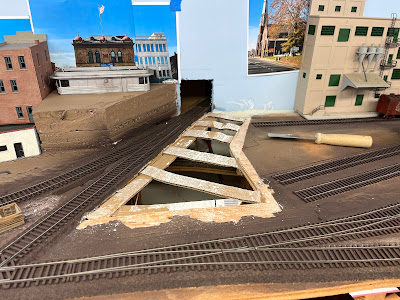If there's one bit of advice I would give to a new model railroader, I think right near the top of the list would be "Learn to use an airbrush." It's one of those skills that, once you've acquired it, you can't imagine how you ever did without it. It's undoubtedly one of the best modeling tools to have in your arsenal.
For the first almost 30(!) years in the hobby, I feared the airbrush. But, thanks to my friend Ralph Renzetti, I've overcome my fear by using his foolproof tools and techniques. On his recommendation, I've also devoured Boomer Diorama's airbrushing how-to videos. Ralph cribbed heavily off of Boomer in developing these easy techniques to get you consistently good results.
In this quick (I promise!) post, I'll cover the 4 main things you need to know to start airbrushing successfully today!
- Airbrush
- Paint
- Technique
- Cleanup
Airbrush - Badger Patriot 105
At first glance, a double-action, internal mix airbrush may seem like an odd recommendation for a beginner, but trust me, once you get used to it, the control you get from a double-action can't be beat.
Most importantly, a double-action allows you to blow just air without paint, and gradually add paint to the airstream. This is critical to minimizing - if not eliminating - tip dry, which will cause your paint to come out splotchy. Blowing air before and after paint will keep the airbrush from clogging and will keep it cleaner during painting. I'll get into the proper technique below.
Paint - Tamiya Acrylics (X and XF)
Tamiya acrylic paint, thinned 50:50 with 91% isopropyl alcohol, shot at 12-15psi with a double-action airbrush will result in just about foolproof results. Tamiya acrylic is very forgiving and can be thinned with a variety of thinners, from Tamiya's own brand of thinner, to water, to lacquer, to IPA. I prefer the IPA since it's easily available and produces consistent results. It also "cleans" the airbrush while you paint.
Trigger Technique - Down & Back/Forward & Up
- Press down the trigger to shoot air;
- Keeping the trigger pressed down, pull back on the trigger to shoot paint;
- When done painting, push trigger forward to shoot straight air again (clearing the nozzle);
- Lift up on the trigger to stop the airflow.
This basic technique will just ensure that you have airflow before and after paintflow (as well as during, of course). Keeping that airflow before and after paint will keep the airbrush from clogging and keep paint from drying at & clogging the tip (the dreaded "tip dry"). Tamiya acrylic paint, thinned as recommended and shot at 12-15 psi, works especially well with this technique.
Painting Technique - Start Paint Before the Model/Stop Paint After the Model
Hold the tip of the airbrush about 3-5" away from the model, off of one end. Start shooting air, moving toward the surface of the model, pulling back on the trigger to apply paint before you reach the beginning of the model. Move steadily as you apply paint across the surface of the model, and as you move past the end of the model, push the trigger forward to stop the paint flow, then lift up on the trigger to stop the airflow.
You should see the paint apply wet and then "dry" almost right away. Overlap your passes to get complete, even coverage.
This basic airbrush painting technique will admittedly take the most practice to master, but using the airbrush/paint/triggering combo I outline above will give you LOTS of leeway and room for error. Practice really is the key. Get some old newspapers, hang them up on a wall, and practice, Practice, PRACTICE.
Trust me, you WILL get the hang of it pretty quickly!
Cleanup
- Dump remaining paint from color cup & wipe out cup.
- Fill cup halfway with isopropyl alcohol (IPA - I use 70% for cleaner, to save my 91%).
- Swish with an old, soft paintbrush, cleaning the inside of the cup.
- Dump cup.
- Repeat steps 2-4.
- Fill cup halfway with IPA.
- "Backwash" by stopping the tip with a paper towel/cloth and shooting IPA. The IPA won't come out of the tip, but will cause air to "backwash" back into the cup. You'll see it bubbling.
- Spray out contents of cup - preferably into a cleaning station.
- Repeat steps 7-8.
- Wipe out cup.
- Remove needle, wipe clean with a paper towel wet with IPA.
- Add lube to needle (Badger "Regdab" needle juice or equivalent lube).
- Replace needle.
To change between colors, I either just spray clean IPA until the airbrush sprays clean, or - to be extra careful - I do an abbreviated version of the above (same steps, but no repeating steps).
Final Thoughts
That's really all there is to it!
- Definitely experiment - Start by familiarizing yourself with the airbrush, just shooting water and grooving the trigger technique.
- Experiment with different thinning ratios - you almost can't go wrong with Tamiya acrylics thinned with IPA. For example, I use a 1:9 ratio of paint to IPA for my fades.
- Experiment with different air pressures too.
That all said, I have to admit that I haven't varied much at all from the above. It works for me and I get good, consistent results. Try it yourself and I bet you get great results too!
As always, be sure to let me know how you do - and if you have any questions I can try to answer - in the comments below!
























































